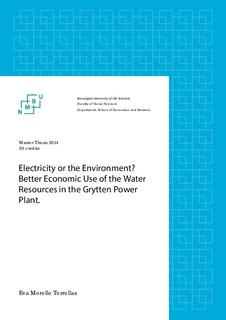| dc.contributor.author | Morello Torrellas, Eva | |
| dc.date.accessioned | 2015-07-29T11:18:49Z | |
| dc.date.available | 2015-07-29T11:18:49Z | |
| dc.date.copyright | 2015 | |
| dc.date.issued | 2015-07-29 | |
| dc.identifier.uri | http://hdl.handle.net/11250/293780 | |
| dc.description.abstract | The once highly controversial Grytten hydroelectric plant that lead to the Mardøla
campaign in 1970, will have its concession reevaluated in 2020. With its construction
two waterfalls of highest national importance, Mardalsfossen and Mongefossen, were laid bare. The Norwegian Water Resources and Energy Directorate proposes that a minimum water flow in Mongefossen be considered for the upcoming revision of the concession, as was earlier adopted in Mardalsfossen in 1990. By employing an environmental benefit-cost analysis (EBCA) as a social appraisal procedure, this thesis evaluates whether or not this proposal is welfare enhancing. With the growing values on tourism, recreational fishing and higher environmental standards combined with current low electricity prices, the conditions surrounding the concession have changed significantly with respect to those of the 1970s and 1980s. For this reason, this thesis also considers other possible measures to enhance social welfare in terms of flow rates and flow periods. This thesis finds that a greater net present value of the EBCA can be achieved if other methods than those proposed by NVE are adopted and that greater quantity of water is better allocated to other purposes than the production of electricity. Three characteristics are identified to be important in this respect: higher flows, longer periods and the possibility daytime/nighttime flow adjustment. Tourism is seen to be crucially important with regards to decision-making between different possible measures. Of sixteen cases considered for Mardalsfossen and Mongefossen, the solution than delivers the highest social surplus is found when daytime/nighttime adjustment of the flow in the waterfalls is combined with higher flow rates at daytime during the high tourist season. Compared to the minimum flow proposal of NVE, the increase in NPV is found to be 105% for Mardalsfossen with an increase in costs incurred by Grytten of 18%. For Mongefossen the corresponding increase in NPV is found to be 83% with an increase in costs of 60%. | nb_NO |
| dc.language.iso | eng | nb_NO |
| dc.publisher | Norwegian University of Life Sciences, Ås | |
| dc.rights | Navngivelse 3.0 Norge | * |
| dc.rights | Navngivelse 3.0 Norge | * |
| dc.rights.uri | http://creativecommons.org/licenses/by/3.0/no/ | * |
| dc.subject | Mardalsfossen | nb_NO |
| dc.subject | Mongefossen | nb_NO |
| dc.subject | Benefit-Cost Analysis | nb_NO |
| dc.subject | Waterfall | nb_NO |
| dc.subject | Hydroelectric power plant | nb_NO |
| dc.subject | Concession | nb_NO |
| dc.subject | Environmental measure | nb_NO |
| dc.subject | Minimum flow | nb_NO |
| dc.title | Electricity or the environment? : better economic use of the water resources in the Grytten power plant | nb_NO |
| dc.type | Master thesis | nb_NO |
| dc.subject.nsi | VDP::Social science: 200::Economics: 210::Economics: 212 | nb_NO |
| dc.subject.nsi | VDP::Social science: 200 | nb_NO |
| dc.source.pagenumber | 145 | nb_NO |
| dc.description.localcode | M-ECON | nb_NO |

